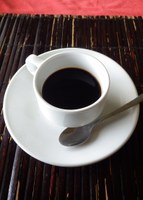Prairie Fare: Is Coffee Good for Your Health?
(Click an image below to view a high-resolution image that can be downloaded)
By Julie Garden-Robinson, Food and Nutrition Specialist
NDSU Extension Service
“Just call me MacGyver,” my husband said, referencing a mid-1980s and 1990s TV show character.
I looked up from my task to see if he was fixing something with a paper clip, chewing gum or his pocketknife, as the secret agent used to do. The TV character often narrowly escaped explosions with his clever solutions to problems.
With the TV images in my mind, I hoped we wouldn’t blow anything up in the sparsely furnished kitchen of the lake cabin our family was renting for a few days.
We weren’t exactly “roughing it” in the wilds. Although we had a kitchen, shower and coffee maker, I prefer a place with a continental breakfast and a pool.
I was doing the best I could making homemade pancakes with the available bowls and spoons and some creative measuring techniques.
I needed a cup of coffee, though. Unfortunately, I discovered that we packed the bag of whole-bean coffee instead of the ground coffee on the way out of our home. The kitchen didn’t have a coffee grinder, and the Robinsons really needed a dose of morning caffeine.
I was ready to drive 20 miles for coffee when my “MacGyver” got a little creative with coffee grinding.
“We’ll have coffee soon,” he said as he used the bottom of a coffee mug and inside of a bowl as a makeshift mortar and pestle.
Our kids found our breakfast preparation techniques intriguing. They wanted to help grind coffee, too, because electronic entertainment was lacking. We had no TV to watch, and I told them to let their cellphones have a vacation, too.
When the coffee was ground, I discovered we had no filters. I got to be MacGyver, too. A paper towel worked quite well as a filter.
However, when I made a pot of coffee later in the day, I discovered I had plugged the coffee pot mechanism. “Lake Coffee” overflowed onto the counter and the floor. We fixed that problem, too. Despite the mishap, I think the fresh-ground, slightly filtered coffee tasted great and the caffeine energized us for a day of exploring.
Coffee has been consumed for at least 1,000 years, long before the time of automatic coffee makers. Coffee grows on tropical evergreen shrubs that produce a fruit with two beans that form inside. After harvest, coffee beans are cleaned, dried and roasted. From light to dark roast, the roasting process promotes the development of color and flavor.
Coffee is one of the most popular beverages in the U.S. According to the National Coffee Association, about 59 percent of people 18 and older enjoy the beverage at least now and then. Among people ages 25 and older, nearly three out of four drink coffee at least occasionally.
According to a 2015 coffee trends report, iced coffee is leading the pack in coffee innovations. In restaurants, other coffee-brewing methods such as “cold brewing” are said to reduce the bitter notes in coffee. Still other restaurants are trying “buttered coffee” with unsalted butter or coconut oil added.
Plain coffee has a negligible amount of calories until you add sweeteners, cream, and various flavorings and toppings. At that point, your fancy coffee beverage may expand to have hundreds of calories. Beverages do not seem to “fill us up” in the same way that foods do.
To slim your beverage, opt for skim milk or lower-calorie syrups if you need an add-in for your beverage.
Coffee is naturally high in antioxidants, and research is under way to determine the health effects of these compounds.
Many studies have shown positive physical and mental benefits. For example, caffeine in coffee may reduce our risk of Parkinson’s disease. Athletes may note that a little caffeine improves sports performance. A 2015 study has shown that drinking coffee may reduce our risk of gallstone disease.
Despite long-standing concerns about coffee and hydration, coffee does not cause dehydration even though caffeine has a mild diuretic effect.
Coffee can have some side effects, and certain groups should watch their intake. Keep in mind that too much caffeine can upset your sleep or leave you feeling jittery or nervous. Pregnant women should follow the advice of their health-care provider about caffeine consumption.
For best nutrition, children and adolescents should quench their thirst with water, milk and 100 percent juice to support their growing bodies while staying hydrated. Many “energy drink” beverages are directly marketed to kids, so parents should be sure that their kids exercise moderation. Some energy drinks contain a large amount of caffeine, along with various ingredients. Water is the best option as a thirst quencher for kids.
How much caffeine is OK for adults? According to the proposed 2015 Dietary Guidelines for Americans, as much as 400 milligrams per day is fine for healthy adults. That’s the amount in three to five cups of coffee. A “cup” is 8 ounces, by the way. Many of our “cups” are much larger than 8 ounces.
What goes well with coffee? How about some homemade pancakes? Here’s the pancake recipe I served with “MacGyver coffee.”
Buttermilk Pancakes
2 c. buttermilk (or substitute reconstituted dry buttermilk)
2 eggs, beaten
1 tsp. salt
1 tsp. baking soda
2 tsp. baking powder
2 Tbsp. sugar
1 3/4 c. all-purpose flour
1 1/2 Tbsp. butter or margarine, melted
Chocolate chips, blueberries (optional add-ins)
Preheat griddle to 375 degrees. Mix buttermilk and eggs together. In separate bowl, stir dry ingredients together (or use a sifter). Stir in buttermilk and egg mixture. Add melted butter and mix. Drop from ladle onto hot griddle, cooking each side about two minutes or until light brown. If desired, add a few chocolate chips or blueberries right after adding the batter to the griddle.
Makes four servings. Each serving has 360 calories, 10 grams (g) of fat, 55 g of carbohydrate and 20 percent of the daily recommendation for calcium.
(Julie Garden-Robinson, Ph.D., R.D., L.R.D., is a North Dakota State University Extension Service food and nutrition specialist and professor in the Department of Health, Nutrition and Exercise Sciences.)
NDSU Agriculture Communication - Aug. 20, 2015
| Source: | Julie Garden-Robinson, (701) 231-7187, julie.garden-robinson@ndsu.edu |
|---|---|
| Editor: | Ellen Crawford, (701) 231-5391, ellen.crawford@ndsu.edu |



